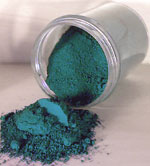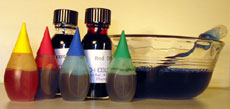Coloring Soap
This article talks about the four main types of colorants you commonly find in soaps and toiletries. These colorant types are pigments, dyes, micas, and botanical (aka natural) colors.
Pigments

Pigments were originally mineral material mined from the earth. Now, they are created in laboratories to exact specifications -- which is a good thing, because the minerals could contain other undesirable components, such as lead, mercury, or arsenic.
The two main types of pigments used in soap are ultramarines and oxides. They color mixtures by dispersion -- that is, by suspending their tiny particles throughout the mixture evenly. They are generally stable in high pH conditions, which means that the colors stay pure and true in CP soap or through a cook in HP.
Pigments are also very inexpensive and generally easy to use, although sometimes it takes a little time to make sure that they're mixed in thoroughly and you don't have little color clumps mixed in through your soap. They do not bleed, so you can have swirls or complex soap mixtures without the colors blending, and they are generally colorfast even in direct sunlight.
Dyes

Dyes are an entirely different product from pigments. Dyes actually change the color of the products that you add them to, which means that there are no clumps to worry about and they will remain transparent if you put them in a transparent product such as M&P or body spritz. However, they are made from a variety of chemicals and are generally not stable across a wide variety of pH conditions -- which means you can add blue dye to your soap and end up with a shade of mutant pink!
Unless explicitly stated otherwise, you should consider untested dyes to be risky in cold process soap. Generally they are perfectly fine in M&P (although some do fade in sunlight - and fast! I once had bars of bright blue M&P fade to transparent in less than three hours). Blue is a particularly difficult shade to work with, and many types of blue dye are extremely unstable and fade quickly. Red also has a tendency to bleed -- that is, to have the color leak into soap that touches it (e.g., if you have a white base with red bits embedded in it, over time, the red bits will turn the white base pink). Although there are techniques that you can use to help avoid color bleeding, it's not something you can entirely prevent.
Dyes come in an incredible array of colors, though, so it's worth taking a little extra care to take advantage of them.
Mica

Mica is a mineral which is used in practically everything you see that's sparkly -- plastic, paint, lipstick, nail polish, glitter. It comes in tiny flakes, which determines how sparkly it is -- the larger the mica particle, the more light it reflects, so "sparkly" mica will have a large particle size, whereas mica used for a "pearl" effect will have a very small particle size.
Mica is a white-silver naturally, but it can be dyed very easily, and you will see a wide array of beautiful shades of mica for sale for soap. Mica sparkles by reflecting light, so it works best in products where it can get a lot of light, such as transparent M&P. Although it does sparkle in opaque soaps, it's not as stunning.
Since mica is used for so many products, it's very important to check that your supplier's micas are cosmetic grade. Some micas may be listed as safe for ingestion and these are the only micas you should use in edible body products (such as lip balms), again because of the dyes or the grade of the product.
Micas are often, but not always, stable in high pH conditions, so you should test micas in CP before you try to make a huge batch.
Botanical Colorants
Finally, there are natural botanicals which you can use to color your soap. Annatto seeds are a favorite for shades of yellow to orange, because they are cheap and very easy to use -- just soak the seeds in some of your base oil for a day or longer, drain the oil off, and use it in your soap -- save the seeds, they're reusable many times! (I keep annatto seeds in a small bottle of oil all the time, then use about 1 tbsp. of the oil for a bright orange shade in 3# of soap.) Powdered rosebuds make a pretty shade of brown, and red sandalwood powder makes a striking maroon (used at 1 tbsp. per pound of soap - make sure the powder is fine or your soap will be scratchy!). Alkanet root powder makes a shade of purple, and madder root powder turns red.
